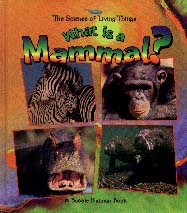|
________________
CM . . . .
Volume VI Number 10 . . . . January 21, 2000
excerpt: Rodents are mammals with long sharp front teeth. They use them top gnaw through things such as wood or the shells of seeds and nuts. Chewing such hard things wears down teeth, but, unlike most mammals, a rodent's teeth never stop growing. A rodent must keep grinding down its teeth, or they will become so long that its jaw will lock shut.Part of the "Science of Living Things" series, What is a Mammal? provides a thorough, entertaining and factual introduction to all types of mammals. The main text is clear and simple, laden with eye-catching photographs and illustrations. For those wishing further information, details are provided in accompanying text boxes or captions to photographs. The book starts by explaining what sets mammals apart from other animals by listing the main groups of mammals. After sections on "A Mammal's Body" and "Mammals' Milk," each group of mammals is described in turn. Odd mammals, such as Pangolins, that do not belong in any of the standard groups are featured on their own in a section at the end. A glossary and an index conclude the book. Although obvious care has been taken to be precise and factual, the text does occasionally overgeneralize. For example, at one point, there is a sentence: "Mammals have hair or fur on their body." The error in this sentence is accentuated as it appears above a picture of a hairless Orca. All the pictures are captioned, with the unfortunate exception of a two-page spread of a leopard. Since many readers may not be familiar with the appearance of some of the larger cats, this omission could be an annoyance. In general, however, this is a wonderful book, both well illustrated and organized. Recommended. Karen Clay is a librarian working in the William R. Neuman Library, Agriculture Building, University of Manitoba.
To comment on this title or this review, send mail to cm@umanitoba.ca.
Copyright © the Manitoba Library Association.
Reproduction for personal use is permitted only if this copyright notice
is maintained. Any other reproduction is prohibited without
permission.
Published by
TABLE OF CONTENTS FOR THIS ISSUE - January 21, 2000.
AUTHORS |
TITLES |
MEDIA REVIEWS |
PROFILES |
BACK ISSUES |
SEARCH |
CMARCHIVE |
HOME
|
